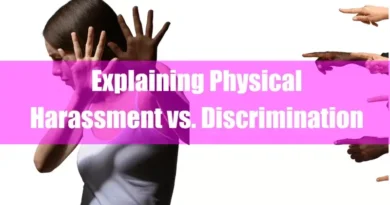Key Takeaways:
Here are the key takeaways from the article on “Leveraging Technology For Harassment Prevention and Reporting”:
- Technology offers powerful tools to combat harassment: Online reporting platforms, AI-powered analysis, educational resources, and bystander intervention tools can all play a role in preventing and addressing harassment.
- Accessibility and anonymity are crucial: Victims are more likely to come forward if they can report anonymously and easily access reporting tools.
- Ethical considerations are paramount: Data privacy, misuse prevention, bias in AI algorithms, and transparency are all critical issues that must be addressed to ensure technology is used responsibly.
- Collaboration is key: Tech companies, policymakers, researchers, NGOs, and affected communities must work together to develop effective and ethical solutions.
- The future holds promise: Technology has the potential to create a world where harassment is a distant memory, but achieving this future requires a human-centered approach that prioritizes safety, equity, and respect.
The article acknowledges that these technologies are still evolving, and their effectiveness depends on specific contexts. It emphasizes the importance of ethical considerations throughout the design and implementation of these technologies.
I. Introduction
In the digital age, the landscape of harassment has evolved beyond physical spaces, weaving its insidious threads into the very fabric of our online interactions. From cyberbullying and stalking to workplace harassment via email and messaging platforms, the pervasiveness of this issue demands innovative solutions. Fortunately, technology – often seen as a breeding ground for harassment – is now emerging as a powerful tool for its prevention and reporting.
II. Leveraging Technology for Harassment Prevention and Reporting
Traditional methods of tackling harassment, while crucial, often prove inadequate. Legal recourse can be cumbersome and lengthy, hotlines lack accessibility, and internal reporting systems within organizations may be shrouded in fear and uncertainty. This is where technology steps in, armed with a unique set of advantages:
- Accessibility: Technology platforms transcend geographical boundaries, reaching even the world’s most remote corners. This can be an invaluable lifeline for individuals in isolated or underprivileged communities facing harassment.
- Anonymity: Fear of retaliation is a major deterrent to reporting harassment. Technology allows victims to come forward anonymously, empowering them to seek help without fear of repercussions.
- Real-time analysis: Unlike traditional systems that rely on delayed reporting and investigation, technology offers the potential for real-time analysis of data and patterns. This enables swift intervention and resource allocation, potentially preventing future incidents from occurring.
With these advantages in mind, let’s dive into the specific ways technology is revolutionizing the fight against harassment:
A. Proactive Measures: Nipping Harassment in the Bud
AI-powered language analysis: Imagine a world where harmful language in online communication is automatically flagged and addressed before it escalates into full-blown harassment. This is the promise of AI-powered language analysis tools. By identifying keywords, phrases, and patterns associated with abusive language, these tools can alert platforms, moderators, or even the individuals themselves, providing an opportunity for course correction before things get out of hand.
1. Predictive analytics and risk assessment:
Imagine anticipating a potential storm before it even brews. Fueled by machine learning algorithms, predictive analytics can analyze past behavior and online activity to identify individuals at risk of perpetrating or experiencing harassment. This information can be used to provide targeted interventions, support, and educational resources, effectively pre-empting incidents before they occur.
2. Bystander intervention platforms:
Witnessing harassment can be a paralyzing experience, often leaving bystanders unsure of how to intervene. Bystander intervention platforms empower individuals to safely and anonymously report witnessed incidents through apps or online portals. This provides valuable data for prevention efforts and offers timely support to both the victim and the potential perpetrator.
B. Educational and Awareness Initiatives
Interactive training modules: Forget boring lectures and stale PowerPoint presentations. Imagine learning about harassment prevention through immersive virtual reality scenarios or engaging gamified experiences. Interactive training modules make learning about different forms of harassment, warning signs, and appropriate responses effective and engaging, especially for younger generations.
1. Digital safe spaces and resource hubs:
In the vastness of the digital world, creating safe spaces dedicated to discussing, understanding, and combating harassment is crucial. Online communities, forums, and resource hubs can provide a platform for open dialogue, knowledge sharing, and peer support, empowering individuals to navigate the complexities of harassment and find solace in knowing they are not alone.
2. Targeted social media campaigns:
Social media, often blamed for facilitating harassment, can also be a powerful tool for raising awareness and sparking change. Targeted campaigns addressing specific types of harassment, like workplace bullying or online stalking, can utilize culturally relevant and engaging content to reach diverse audiences and drive positive social change.
C. Environmental Design and Safety Protocols
Smart building technology: Imagine entering a public space where sensors and surveillance systems work not to spy on you but to protect you. Smart building technology can monitor activity in vulnerable areas, detect unusual behavior patterns, and even deter potential harassment before it happens. This can be particularly useful in places like public transportation, universities, and workplaces.
1. Emergency alert systems:
Feeling unsafe shouldn’t leave you feeling voiceless. Integrated with reporting platforms, wearable devices, and panic buttons can allow individuals to discreetly and silently alert authorities or trusted contacts in case of immediate danger. This can be a critical lifeline for individuals facing physical harassment or stalking.
2. Cybersecurity measures:
Just as we lock our doors to protect our physical belongings, we must safeguard our online spaces. Robust cybersecurity measures like strong passwords, two-factor authentication, and data encryption are essential to prevent unauthorized access to personal information, a common tactic used in online harassment and cyberbullying.
Also, read:
III. Empowering Victims with Powerful Tools

A. Accessible and Anonymous Reporting Channels
- Multilingual and Culturally-Sensitive Apps: Imagine a reporting platform that speaks your language, literally and figuratively. Multilingual apps break down linguistic barriers, catering to diverse audiences and ensuring everyone feels heard. Cultural sensitivity ensures the platform understands local nuances and context, providing resources and support tailored to specific needs.
- 24/7 Availability and Accessibility: No more waiting for business hours or grappling with closed doors. Accessible and anonymous reporting apps are always open, offering a safe space for victims to come forward anytime, anywhere. Whether you’re facing harassment at work at midnight or on a solo adventure abroad, help is just a click away.
- Empowering Anonymity: Fear of retaliation often stifles the voices of victims. Anonymous reporting removes this barrier, allowing individuals to disclose incidents without worry. This protects them from potential consequences and encourages more disclosures, leading to better understanding and prevention of harassment.
- AI-powered Chatbots and Virtual Assistants: Feeling lost or unsure how to proceed? AI-powered chatbots and virtual assistants become empathetic listeners and knowledgeable guides. They provide emotional support, answer questions, and walk victims through the reporting process, ensuring they feel supported and empowered.
B. Streamlined Data Collection and Analysis
1. Standardized Reporting Formats:
Imagine all pieces of the puzzle fitting seamlessly together. Standardized reporting formats across platforms ensure consistency and clarity, regardless of where the report originates. This allows for efficient data collection, analysis, and comparison, providing a holistic picture of the harassment landscape.
2. Real-time Data Dashboards:
No more waiting for dusty reports or outdated statistics. Real-time dashboards visualize trends and patterns in reported incidents, vividly showing where, how, and who is experiencing harassment. This empowers authorities and organizations to tailor prevention strategies and resource allocation with razor-sharp precision.
3. AI-powered Insights and Prioritization:
Think of AI algorithms as digital detectives, sifting through mountains of data to uncover valuable insights. They can identify potential false reports, prioritize high-risk cases based on severity and patterns, and even predict future incidents before they occur. This ensures the most vulnerable individuals receive immediate help and resources are directed towards where they’re needed most.
C. Collaborative Networks and Support Systems
1. Connecting Victims with Relevant Resources:
No more navigating a maze of unfamiliar options. Dedicated platforms seamlessly connect victims with the resources they need based on their specific situation and location. Legal aid, counseling services, and advocacy groups become readily accessible, eliminating the burden of information overload and ensuring timely support.
2. Building Peer Support Communities:
Imagine a safe haven where shared experiences become weapons against isolation. Online and offline support groups foster a sense of belonging and empower survivors through shared stories, tips, and encouragement. Whether it’s a forum buzzing with relatable anecdotes or a local support group offering a comforting shoulder to cry on, these communities provide invaluable solace and strength.
3. Cross-platform Integration and Community Awareness:
Breaking down silos between reporting platforms and social media sites creates a powerful ripple effect. Real-time updates about reported incidents can inform communities, allowing bystanders to offer support and authorities to intervene swiftly. This fosters a sense of shared responsibility and empowers everyone to play a role in preventing harassment.
IV. Ethical Considerations and Potential Pitfalls

While the promise of technology in revolutionizing harassment prevention and reporting is undeniable, we must tread with caution and acknowledge the challenges and ethical considerations that come with wielding this powerful tool. Ignoring these pitfalls could jeopardize the very goals we aim to achieve, potentially exacerbating existing inequalities and undermining trust in these solutions.
A. Privacy Concerns
The effectiveness of technology often hinges on data collection. However, this can raise privacy concerns, particularly in the context of anonymous reporting. Striking a balance between effective data analysis and individual privacy is crucial. We must ensure transparency in data collection practices, implement robust anonymization protocols, and empower individuals with control over their data.
B. Potential for Misuse
Technology, designed for good, can be perverted for malicious purposes. There’s a risk of weaponizing reporting platforms for false accusations, cyberbullying, or targeted harassment. Robust safeguards are needed to prevent misuse, such as verification procedures, abuse detection algorithms, and clear guidelines for platform usage.
C. Accessibility and Digital Divide
The digital divide can exclude marginalized communities from accessing and utilizing technology-based solutions. Multilingual platforms, offline reporting options, and digital literacy training programs are crucial to ensure equitable access and inclusivity. We must actively bridge the gap and prevent technology from further widening existing inequalities.
D. Bias and Discrimination
Despite their sophistication, AI algorithms can perpetuate existing biases and discriminatory practices. Training data sets must be carefully curated to avoid reinforcing biases based on race, gender, or other factors. Additionally, transparency and human oversight are crucial to ensure algorithmic fairness and prevent unintended consequences.
E. Power Dynamics and Control
Technology shouldn’t exacerbate existing power dynamics or create new hierarchies. For example, surveillance technologies in public spaces must be carefully considered to ensure they don’t disproportionately target or discriminate against certain groups. Empowering and educating marginalized communities about their rights and technological resources is critical to prevent technological solutions from becoming instruments of control.
F. Transparency and Accountability
Building trust in these technological solutions is paramount. Platforms and developers must be transparent about their data collection practices, algorithms, and decision-making processes. Independent audits and accessible grievance mechanisms are necessary to ensure accountability and hold players responsible for potential misuse or ethical breaches.
Navigating these challenges requires a collaborative approach. Open dialogue between tech companies, policymakers, researchers, NGOs, and the affected communities is crucial to developing ethically sound and socially responsible solutions. Building trust through transparency, inclusivity, and a commitment to human rights must be the guiding principle in designing and deploying technology for combatting harassment.
Also, get deep insights from:
- Explaining Religion-Based Quid Pro Quo Harassment
- Explaining National Origin-Based Quid Pro Quo Harassment
- Explaining Age-Oriented Quid Pro Quo Harassment
- Explaining Color-oriented Quid Pro Quo Harassment
V. A Future Without Harassment
Imagine a world where harassment is not a pervasive shadow but a distant memory. This future, while aspirational, is within reach if we leverage the power of technology responsibly and work together to dismantle the structures that enable it. Let’s envision the possibilities when we harness tech for good and forge a collaborative path toward a harassment-free future.
A. Empowering Individuals and Communities
Technology can equip individuals with the tools to protect themselves and build safe spaces. Imagine:
- Personal safety apps: Wearables and smartphones integrated with emergency alert systems and local support networks empower individuals to feel secure in public spaces.
- AI-powered bystander intervention tools: Real-time detection of potentially harmful interactions triggers alerts and resources, enabling bystanders to intervene and prevent incidents before they escalate safely.
- Online communities for healing and support: Virtual safe spaces fostered by AI moderation and human facilitators build resilience and empower survivors to share experiences and find solace.
B. Transforming Prevention and Education
Technology can create engaging and immersive experiences that educate and empower:
- VR simulations and gamified scenarios: Experiencing harassment through virtual reality allows individuals to recognize warning signs, practice communication skills, and learn de-escalation techniques in a safe, controlled environment.
- Interactive training modules for workplaces and schools: Tailored online training programs equip individuals with tools for identifying and preventing harassment, promoting a culture of respect and awareness.
- AI-powered chatbots and virtual mentors: Conversational AI guides provide confidential support, answer questions, and offer personalized resources on preventing and reporting harassment.
C. Collaborating for Systemic Change
Technology can bridge gaps and connect stakeholders to drive comprehensive change:
- Cross-platform data analysis and information sharing: Anonymized data insights facilitate collaboration between platforms, authorities, and researchers, informing prevention strategies and resource allocation across sectors.
- AI-powered policy development and legal recommendations: Machine learning algorithms can analyze trends and patterns in reported cases, generating data-driven policy proposals and legal frameworks to address specific types of harassment.
- Global networks and knowledge exchange: Online platforms build bridges between communities and organizations across borders, fostering knowledge sharing and collaborative action towards global solutions.
D. A Human-Centered Approach to Technology
The future of technology in combating harassment lies in a human-centered approach. This means:
- Prioritizing ethical development and responsible implementation: Designing technology with ethical considerations at its core, incorporating feedback from diverse stakeholders, and ensuring algorithmic fairness and transparency.
- Protecting the privacy and upholding human rights: Striking a balance between effective data collection and individual privacy, empowering users with control over their data, and ensuring technology protects, not undermines human rights.
- Fostering digital literacy and inclusivity: Bridging the digital divide through education and resource allocation, ensuring everyone has access to and can benefit from technology-based solutions.
Building a future without harassment demands a collective effort. Technology is a powerful tool, but it alone cannot dismantle deeply ingrained societal structures and power dynamics. The responsibility lies with all of us: tech companies, policymakers, researchers, organizations, and individuals. By working together, leveraging technology responsibly, and embracing a human-centered approach, we can create a world where harassment is not a constant fear but a fading memory, replaced by a culture of respect, empathy, and inclusivity.
Also, read:
- The Role of Empathy in Harassment
- Fostering a Culture of Respect and Open Communication
- Explaining Quid Pro Quo Harassment Under Title IX
- Quid Pro Quo Harassment: What It Is? Know Everything
VI. Important Notes
A. Safeguarding Against Misuse: A Web of Defense Against False Accusations and Cyberbullying
The potential for tech-based solutions to be misused for false accusations, cyberbullying, or targeted harassment cannot be ignored. To combat this, a multi-pronged approach is necessary. Implementing verification procedures adds a layer of protection. Multi-factor authentication requires corroborating evidence for specific claims, and involving human moderators in high-risk cases can help prevent frivolous or malicious reports.
Furthermore, abuse detection algorithms can offer valuable assistance. These algorithms can flag suspicious patterns, unusual language, or repeated reports against the same individual, identifying potential malicious intent before it escalates. However, relying solely on AI can be risky.
Therefore, establishing clear guidelines and community moderation remains crucial. Platforms need user agreements with explicit rules against misuse, enforced through a combination of human and AI moderation. Additionally, providing accessible avenues for reporting abuse empowers users to flag malicious activity and ensure the platform remains safe.
B. Bridging the Digital Divide: Ensuring Equitable Access for All
Technology-based solutions hold immense potential, but the digital divide threatens to leave marginalized communities behind. Several measures are essential to bridge this gap. Offering multilingual and offline reporting options is a critical first step. Platforms should cater to diverse language needs and provide alternative reporting channels like dedicated phone lines or community centers for those lacking internet access.
However, access to technology itself is equally important. Investing in digital literacy training programs that equip marginalized communities with basic computer skills and internet access is crucial for effectively utilizing these solutions. This can involve community-based initiatives, partnerships with local organizations, and targeted funding for digital literacy programs.
Finally, targeted resource allocation plays a vital role. Prioritizing funding and support for programs that provide technology access and training to underserved communities ensures everyone can benefit from these powerful tools. By addressing the digital divide, we can create a more inclusive future where technology empowers everyone to combat harassment, regardless of their background or access to technology.
C. Avoiding Bias in AI: Fair Algorithms for a Fair Future
Despite their potential, AI algorithms can perpetuate existing biases based on race, gender, or other factors. To prevent this, careful consideration and proactive measures are needed. First, it’s crucial to curate diverse training data sets. Algorithms learn from the data they are trained on, so ensuring they reflect various genders, races, cultures, and backgrounds is essential to avoid reinforcing existing biases.
Secondly, regular bias audits and human oversight are crucial. Regularly monitoring and evaluating algorithms to detect and address potential biases is essential. This can involve employing diverse teams of researchers and reviewers and human intervention to override biased decisions when necessary. Finally, transparency and explainability of algorithms play a vital role in building trust. Making the decision-making process behind AI algorithms more transparent and accessible to users fosters trust and confidence in their fairness.
D. Balancing Privacy and Data Analysis: Protecting Individuals in Anonymous Reporting
While anonymous reporting provides a safe space for victims, privacy concerns remain. Striking a balance between effective data analysis and individual privacy requires transparency and user control. Platforms must be transparent in their data collection practices, clearly informing users about what data is collected, how it’s used, and who has access to it. This allows for informed consent and builds trust.
Furthermore, robust anonymization protocols are essential. Strong encryption methods and data anonymization techniques protect individuals’ identities while enabling valuable data analysis for prevention efforts. Finally, empowering individuals with control over their data is crucial. Options to delete their data, opt out of specific data collection initiatives, and manage their privacy settings on reporting platforms create a sense of ownership and control over personal information.
We can move forward confidently by addressing these challenges, ensuring technology remains a powerful tool for preventing harassment and building a safer, more inclusive world for everyone.









